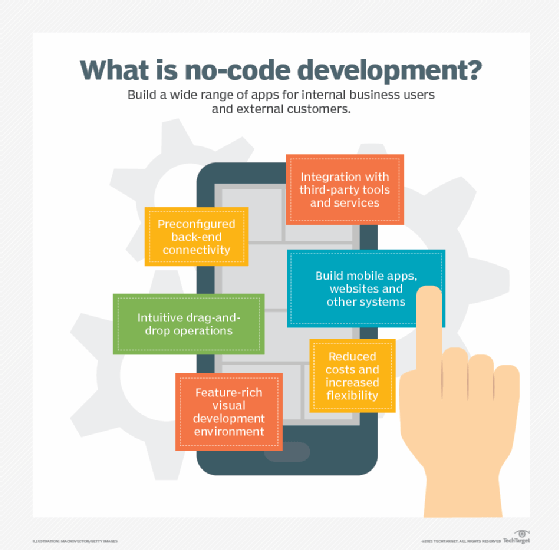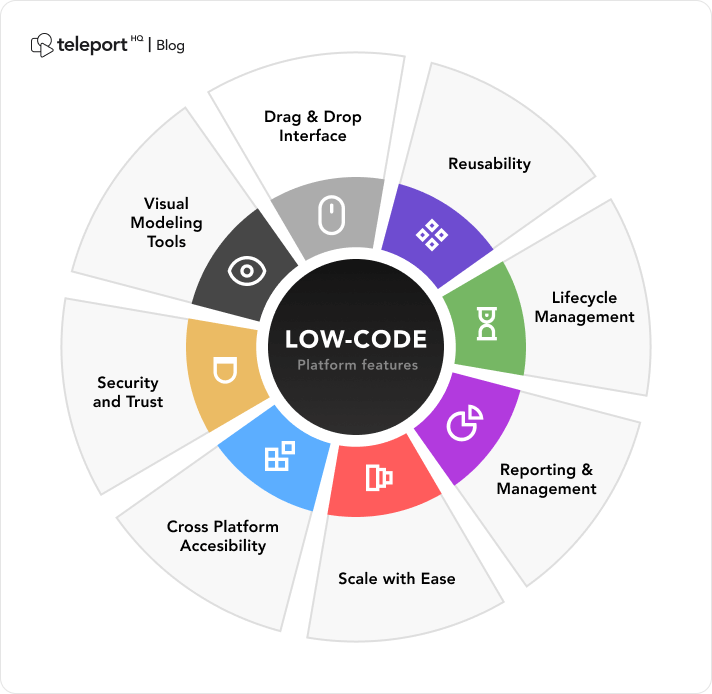New News On Selecting Legacy application modernization with Low-code
Wiki Article
The Advantages Of Developing Low-Code For Speed
Visual Development Environment (VDE):
Drag-and-Drop Interfaces: Low-code platforms provide visual tools for designing applications. Drag-and-drop elements can be used by developers to create apps without extensive code.
Pre-built Templates and Components: A lot of low-code platforms have already-built templates and components which allow developers to rapidly prototype and build applications without starting from starting from scratch.
Reducing Coding requirements
Automated Code Generation: Low-code platforms automatically generate the underlying code based on the visual models designed by programmers. This eliminates the need for manual code writing and accelerates the process of development.
Reusable component: Developers can use the same components for different projects. This reduces the time spent writing code and testing.
Collaboration can be made easier.
Low-code platform tools usually contain versions control, testing, or deployment. This allows for seamless collaboration between teams.
Citizen Development: Non-developers and business users can use intuitive interfaces to contribute to the creation of applications, which can reduce bottlenecks caused due to a shortage of professionals to develop applications.
Rapid Iteration and Prototyping:
Rapid prototyping. Developers can build prototypes in a short time to test their ideas as well as get feedback. This leads to a more efficient iteration.
Easy Modifications: Low-code development is oriented towards visuals, which makes it easier to change and update applications. It can also speed the process of refining and optimizing applications in response to user feedback.
Pre-built Integrations:
API Integrations. A number of low-code platforms offer connectors that are designed to work with well-known APIs and services. This will speed up the process of integrating systems.
Data integration: Tools for data integration are included to help simplify the process.
Deployment Scaling
One-Click deployment: Many platforms that make use of low-code have the option of deploying with one click applications, which can reduce time and effort.
Cloud-based Solutions: Cloud platforms with low-code let developers focus on the logic and functionality of their apps rather than worrying about the logistics of deployment.
Overall, the advantage of developing low-code applications in terms of speed lies in the ability of it to simplify and automate many aspects of the development process. This allows quicker delivery of applications as well as faster adaptation to the changing demands. Read the top Low-code Platform for application development for more examples including low code development platforms, app dev platform, mobile development platforms, no code platforms, jdbc server, application modernisation, stored sql procedures, database in azure, paas service, cross platform mobile app development and more.

The Benefits Of Low-Code Development In The Areas Of Governance And Security
Low-code development can bring many advantages regarding security and governance. These are important to ensure that apps are secure, reliable and well-managed throughout their entire lifecycle. These are the benefits of low-code application development:
Unified Management Console : Low-code platforms have a central administration console that allows administrators to manage and oversee all applications. This helps ensure that the same governance is maintained throughout the organization.
Role-Based Access Control RBAC (RBAC). These systems typically have robust access control that is that is based on roles, giving administrators to establish and apply their own access rules. Only authorized users are able to access and modify specific areas of an application.
Compliance and Regulatory Application:
Many low code platforms include built-in compliance features. They are designed to ensure that the applications are compliant with industry standard (e.g. GDPR, HIPAA). They offer tools and frameworks to help ensure that applications comply with these standards.
Audit Trails and Logging Comprehensive logs and audit trails can be integrated to allow companies to monitor changes as well as monitor access to ensure the compliance.
Enhance Security Measures
Data Encryption. Low code platforms usually offer built-in encrypted data during transport and during rest. This protects sensitive information.
Security Certifications A lot of low-code vendors have security certificates (e.g. ISO 27001, SOC 2 ) that demonstrate the compliance with security standards of high quality. This gives additional security for the customers.
Automated security updates:
Regular patching and updates Low-code platforms can handle the majority of security patches and updates automatically. They ensure that applications are safe from the most recent attacks without requiring developers to intervene manually.
Security Monitoring: Continuous security monitoring tools are included to provide real-time notifications as well as information about potential security issues.
Data Governance
Data Access Policies: These platforms enable companies to establish and enforce policies regarding data access, ensuring that data is only accessible only to those who have been granted access and used appropriately.
Data Masking, Anonymization and Anonymization Tools: These programs assist to protect sensitive personal information and are particularly helpful for testing environments.
Application lifecycle management that is consistent:
Pipelines for Development and Deployment: Low-code platforms often provide integrated pipelines for development and deployment which include security checks, which ensure security remains intact throughout the application lifecycle.
Version Control. Integrated version management can help identify and reverse any modifications that are made to the program, while ensuring that its integrity is maintained.
User Authentication and Authorization:
Single Sign-On (SSO). Support for advanced authentication and single sign-on simplifies and increases security.
Multi-Factor Authentication Most platforms allow multi-factor Authentication that adds an extra layer to security when accessing applications.
Policy enforcement and Compliance monitoring:
Low-code platforms usually come designed with policies that are pre-defined to assist organizations in implementing security and governance policies swiftly.
Tools for Monitoring Compliance These tools are able to monitor and continuously report on the status of compliance. They help to find issues and deal with the issues in a proactive way.
Integration into Existing Security Infrastructure
Seamless Integration: Low-code systems are designed to be integrated with existing security tools and infrastructure, such as identity management systems SIEM (Security Information and Event Management) solutions, and firewalls.
API Security: Integrated API security makes sure that integrations with an external system are secured. Protect data and maintain the application's consistency.
Best practices and Training
Guided Best Practices: Many platforms offer guidelines and best practices for developing secure applications and help non-developers comply with security standards.
Security Training: Some low-code vendors provide security training and resources to educate users on how to design and build secure applications.
Overall, low-code application developers have a security and governance advantage that enables them to develop and manage applications in a safe, secure and secure manner. These platforms offer the tools and frameworks needed to safeguard sensitive data as well as enforce policies and ensure regulatory compliance, while facilitating the management and oversight. Have a look at the top read this post here on Legacy application modernization with Low-code for site advice including rad application development, rapid application design, sso azure, push notifications android, app dev platform, push notifications android, lowcode no code, cross platform mobile development, build a docker container, jdbc server and more.

Benefits Of Low-Code Application Development In Terms Of Collaboration And Workflow
Low-code app development is an excellent choice for businesses who want to increase team efficiency by streamlining the development process. These are the major benefits.
Unified Development Environment : Low-code platforms offer a unified, single environment in which all team members can collaborate efficiently, including designers, business analysts, and stakeholders. This helps eliminate barriers.
Visual Development Tools - The drag-and-drop visual nature of low-code platforms allows non-technical personnel to easily participate in the development process. This helps ensure that all requirements of the business are captured and implemented accurately.
Improved Communication:
Real-Time Collaboration Many low-code applications offer real-time capabilities, like commenting and editing simultaneously, or instant feedback. This enables continuous communication, and helps to reduce the amount of time spent on back-and-forth discussions.
Workspaces shared by teams. Teams can collaborate in shared workspaces. In this workspace, they can view, edit and talk about various project components.
Workflow management simplified:
Built-in Tools for Project Management: Platforms that are low-code typically have integrated project management tools that help teams plan, track, and manage their development projects. This includes task assignment as well as progress tracking and deadline management.
Workflow Automation Automating repetitive tasks and workflows can help reduce manual mistakes and work which allows employees to focus on the strategic tasks while increasing efficiency.
Speedier Iteration cycles
Rapid Prototyping : Low-code systems enable rapid prototyping. They also allow iterative and rapid development. This allows teams to create apps, test them and refine them in shorter periods of time. This allows feedback to be quickly integrated into the application as well as rapid enhancements.
Agile Development Support: Supporting agile methodology lets teams and individuals work in small steps. This also makes it possible to quickly adjust to changing circumstances.
Accessibility for those who are not developers
Citizen Development: Low-code platforms allow users in the business (citizen developers) to create and modify applications without extensive coding knowledge. This alleviates the burden of IT as well as development teams and facilitates faster response to the business demands.
Training and Onboarding. The user-friendly interfaces of training tools help new members to get acquainted with the system. this enhances teamwork.
Centralized documentation Knowledge sharing, dissemination and centralization:
Documentation is integrated into low code platforms often come with the tools needed to create and manage documentation within the platform, making it simple for all project details to be centralized.
Knowledge Repositories : Teams are able to build knowledge repositories that include templates, best practices and reused components. This allows for sharing of knowledge and helps reduce duplication of effort.
Consistency and Standardization:
Standardized components: A standardized, pre-built component ensures uniformity in applications. Team members can understand and work with greater ease on various parts.
Governance and Governance and Compliance: Built-in governance structures ensure that every development is in line with organizational standards and regulatory requirements, reducing the possibility of non-compliance as well as making sure that the applications are in compliance with quality standards.
Feedback and Improvement Loops
Integrated Feedback Mechanisms Low-code platforms typically have integrated feedback mechanisms that allow users to easily provide feedback to applications. This can later be integrated into the development process.
Continuous Improvement: The capability to quickly test deployment, change and deploy applications in response to user feedback allows them to be aligned with the business objectives and user requirements.
Visualization and Reporting
Real-Time Analyses: The built-in reports and analytics tools give instantaneous insight into the project's performance, progress and user interaction, allowing the use of data to make informed decisions.
Visual Workflow mapping: Visual tools to create workflow maps can be used by teams to enhance workflows. This allows them to identify the bottlenecks, as well as areas to improve.
In terms of collaboration, low-code applications are a great way to streamline workflows, bring teams from different backgrounds together, and automate tasks. This results in a more efficient, flexible and efficient development environment that leads to more efficient and high-quality applications.
